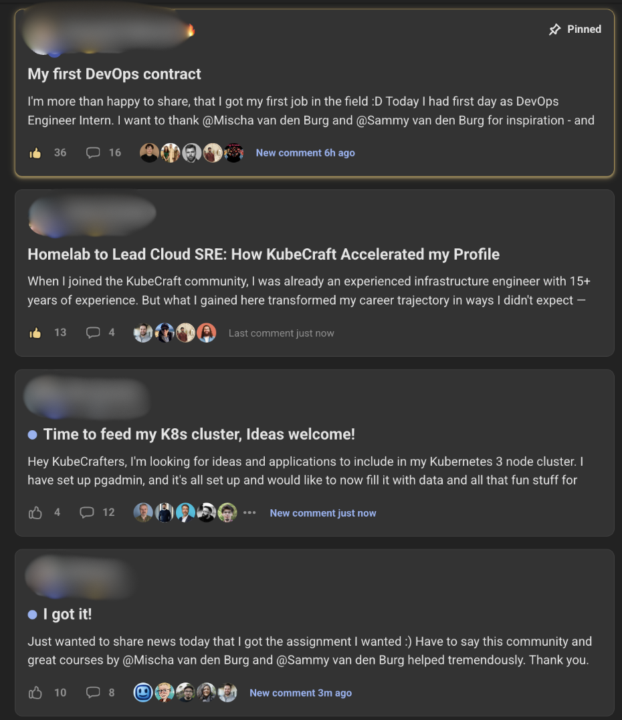
Write something
Pinned
Start Here: Introduce Yourself & Get Your First Win
Welcome to KubeCraft. The community where (aspiring) DevOps engineers become undeniable. You are not here to collect endless tutorials. You are here to get hired, build real skills, and move forward with people who want the same outcome. Inside KubeCraft, we share one mission: Become a high paid DevOps engineer while solving real world problems together trough DevOps Craftsmanship. You are no longer doing this alone. You are part of a focused group built to push your growth every step of the way. We help you to: • Build real world DevOps skills through projects, challenges, and proof of work • Land your first DevOps role or level up your current one • Stay accountable inside a community that expects action, not excuses You are in the right place if: • You want to become a DevOps or Cloud engineer and are passionate about this craft • You are willing to do the work, ask questions, and support others • You want a real DevOps environment, not another passive course platform Follow these steps: 1. Post your introduction below (and level up to level 2+ fast) 2. Like & reply to other introductions 3. Your onboarding shows how this community works and what is expected 4. You will see exactly how to create momentum fast with the Welcome to the KubeCraft, Crafter. Let’s get to work.
Poll
2505 members have voted
Pinned
⚔️ KubeQuest Monday is LIVE
Good afternoon Crafters! As we’re closing 2025, this is what finishing strong looks like. Last week @Adeyemi Ojo executed KubeQuest exactly as intended. Three goals set. Three goals completed. Proof delivered. He moved from testing things to running a real setup. That’s exactly how KubeQuest is meant to be used. Nice work @Adeyemi Ojo and thanks for setting the example 🙌 ⚔️ 𝗞𝘂𝗯𝗲𝗤𝘂𝗲𝘀𝘁 𝗠𝗼𝗻𝗱𝗮𝘆 𝗶𝘀 𝗹𝗶𝘃𝗲 New week. New focus. New progress. We keep it simple 👇 𝗦𝗧𝗘𝗣 𝟭: 𝗪𝗲𝗲𝗸𝗹𝘆 𝗚𝗼𝗮𝗹𝘀 (𝗠𝗼𝗻𝗱𝗮𝘆) Post your 1–3 DevOps goals for the week in the comments under this post 𝗦𝗧𝗘𝗣 𝟮: 𝗨𝗽𝗱𝗮𝘁𝗲 & 𝗪𝗶𝗻 (𝗙𝗿𝗶/𝗦𝘂𝗻) Before the week ends, reply to your own comment with: - Your status update - Your biggest win Whether everything is completed or not, showing up and reporting back is what counts. 🗓️ 𝗧𝗶𝗺𝗲𝗹𝗶𝗻𝗲: Weeks run from Monday to Sunday 👉 𝗘𝘅𝗮𝗺𝗽𝗹𝗲 𝗦𝘂𝗯𝗺𝗶𝘀𝘀𝗶𝗼𝗻: See the example below. Each week we'll create a fresh new post to keep the momentum going 🏆 𝗪𝗲𝗲𝗸𝗹𝘆 𝘄𝗶𝗻: Each week we select one member who posted their goals and returned with an update. They receive a community shoutout 🌟 Post your goals today, then return on Saturday or Sunday to share your proof 🔥 Good luck this week!! PS: Use this week to build and learn. Reach out to someone in the comments and show some support.

Where are you from?
Hi friends, May I ask you a question? Please post in the comments where you are from. This way, we can see where all the members live. Afterward, take a look through the comments and feel free to like or say "hi" to members who are from your area. I'm super curious to see where you're all from and will read every single comment. Let's gooooo! - Mischa 🫡

This Is Why Real DevOps Skills Beat Tutorials Every Time
In a single day 3 KubeCraft Career Accelerator members shared landing roles. From Junior all the way to Lead SRE. Here's what they had in common so you can learn from it: - None of them relied on watching tutorials, asking ChatGPT for quick answers, or copying examples. - They built real environments. Real clusters. Real problems to fix. - When interviewers asked about Kubernetes troubleshooting or GitOps workflows, they didn’t speak in theory. They walked through actual incidents from their own setups. What broke. Why it broke. How they fixed it. - They knew in advance what would happen, how it would go and what to respond. - They followed a proven, system-backed structure. This cuts results to weeks instead of years of confusion and stress. The same mindset you use in production is the one you develop when you’re building your own systems from scratch. One member said: “The homelab helped me land interviews, but the lifestyle of constant improvement is what changed me.” Some people think the homelab is 'just' for the resume.. It’s not. It rewires how you think. A way of thinking thats actually valued by the job market. For those who missed it, Here's how you can build a Kubernetes Homelab in 30 minutes: https://youtu.be/NkM6wQL2UvM Want to ride the next hiring wave coming up next month? We have 4 spots left for this month. You can apply at www.kubecraft.dev
9
0

Levels 1 to 3? Say hello :-)
This post is for everyone who's still on levels 1 to 3. Go on, say hello :-) Anyone who's level 4 or higher is only allowed to use the reply function. Let's see if this works here -Mischa
1-30 of 880

skool.com/mischa
Only for DevOps Engineers
Get hired to build the future
Use the Community, Blueprint and the KubeCraft Roadmap
Powered by






